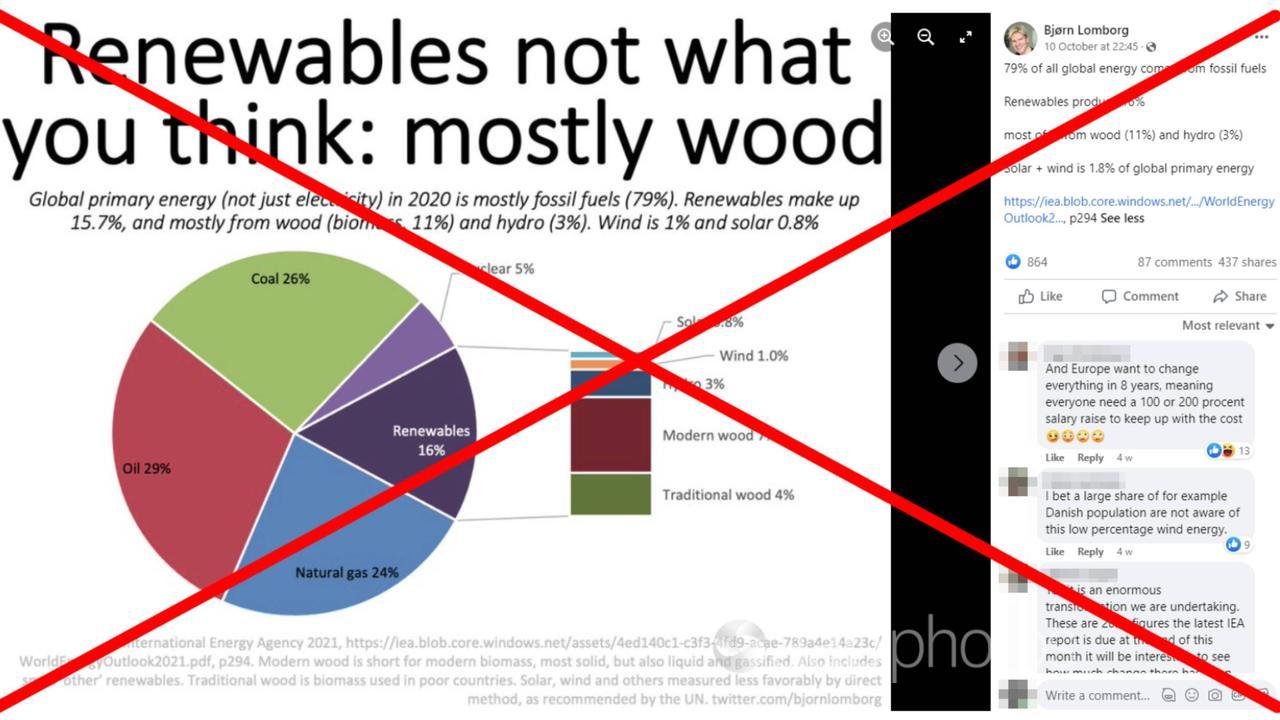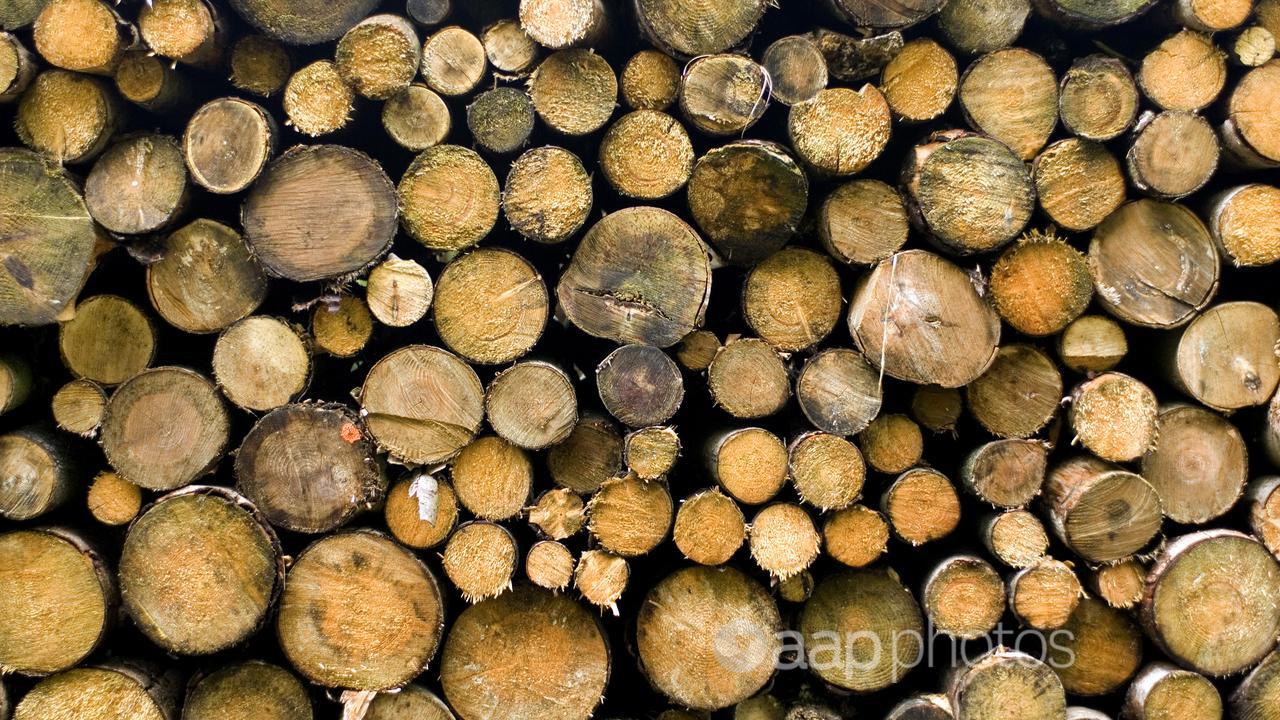A Facebook post claims the use of wood makes up 71.9 per cent of the world’s renewable energy supply.
The claim is false. The International Energy Agency (IEA) and a climate scientist told AAP FactCheck that data from the IEA’s World Energy Outlook (WEO) 2021 report has been erroneously grouped to over-represent the use of wood.
The post is from Danish author Bjørn Lomborg, who has written several books on the environment with a focus on the economic impact of climate change mitigation.
His post features a pie chart detailing the sources of the world’s energy supply from 2020 based on data from the WEO report (page 294). The post features the headline: “Renewables not what you think: mostly wood”.
Dr Lomborg’s chart states fossil fuels account for 79 per cent of global energy, while renewables make up just shy of 16 per cent.
He claims that of the 16 per cent of the total energy supply, 11 per cent of the total is “from wood” with the rest made up of hydro power (three per cent), wind (one per cent) and solar (0.8 per cent).
Text beneath the chart reads: “Modern wood is short for modern biomass, most solid, but also liquid and gassified. Also includes small ‘other’ renewables. Traditional wood is biomass used in poor countries.”

However, the IEA told AAP FactCheck the claim is incorrect.
“Although the original data are taken from an IEA’s publication, they have been further edited and erroneously grouped into new categories that do not exist in our World Energy Outlook publication,” an IEA representative said in an email.
The IEA report states the total world energy supply for 2020 as 589.1 exajoules (EJ).
Dr Lomborg reaches his 16 per cent renewables figure by combining the report’s total for renewables (12 per cent) with the “traditional use of biomass” category (four per cent).
However, the IEA’s table clearly separates the traditional use of biomass category from renewables.
An IEA representative confirmed this, telling AAP FactCheck it makes the distinction with traditional use of biomass “because it is not sustainable and it should be phased out soon.”
He added: “Putting it together with the rest of renewables would mask the targeted growth of sustainable renewables in these annual reports.”
Dr Lomborg than calculates the 11 per cent wood figure by adding modern solid bioenergy (31.8 EJ or five per cent ), modern liquid bioenergy (3.8 EJ or one per cent), modern gaseous bioenergy (2.2 EJ or 0.37 per cent), other renewables (4.5 EJ or one per cent) and the aforementioned traditional use of biomass (24.1 EJ or four per cent).
This equals 66.4 EJ, which equates to 71.9 per cent of Dr Lomborg’s erroneous renewables figure (92.4 EJ) or 11.3 per cent of the total world energy supply.
The IEA said Dr Lomborg had made several errors in his calculations, largely by incorrectly grouping categories together and classifying them as wood.
Firstly, the IEA said he is wrong to include “other renewables” for his wood total, as it instead refers to geothermal and tidal and wave energy sources.
“This does not include any wood consumption,” the IEA said.
Secondly, the IEA said his classification of modern solid bioenergy as wood is an “incorrect simplification of this category”.
While it does include some wood, the IEA added: “Modern solid bioenergy category also includes organic waste streams, such as solid manure, and conventional bioenergy crops, such as wheat, corn or soy seed. Organic waste makes up over one-third of global bioenergy supply today.”
Thirdly, the IEA said he is wrong to include modern liquid bioenergy and modern gaseous bioenergy for his total figure for wood.
Modern liquid bioenergy includes bioethanol, biodiesel and biojet fuel while gaseous bioenergy includes biogas produced via anaerobic digestion and biomethane.
The IEA said if any liquid or gaseous biofuels are produced from solid biomass feedstock, then the amount required would be reported under modern solid bioenergy.

The IEA directed AAP FactCheck to its definitions on page 351 of the report, noting Dr Lomborg’s definition for “traditional wood” as “biomass used in poor countries” does not correspond with its definition.
Annette Cowie, senior principal research scientist at the NSW Department of Primary Industries’ Climate Branch, told AAP FactCheck there is a lot of misinformation around forest bioenergy and she pointed to several errors made by Dr Lomborg.
She confirmed traditional biomass is not considered or classified as renewable given it is often associated with “unsustainable rate of harvest”.
She added: “Liquid and gaseous biofuels do not come from wood; liquid biofuels are mostly ethanol from corn and sugarcane, plus biodiesel from canola and palm oil and tallow, as explained in the definition of conventional liquid biofuels (p355); breakdown of fuels is shown on p223.
“Biogas comes from manure, landfill, sewage treatment, food waste, other agricultural residues, eg oil palm residues, abattoir wastes (p237+).”
Dr Cowie added that solid bioenergy is mostly “forest biomass” often in the form of pellets used for electricity generation.
She said the category would also include the likes of crop straw and nut shells such as walnut, coconut, macadamia and almond as well as palm kernel shells.

Dr Cowie, who has co-authored a review on the subject, added: “It should be noted that forest biomass used for energy comprises harvest residues (branches, bark), mill residues (sawdust, offcuts) and low quality logs (parts of tree stems that are damaged by storm or insect attack, twisted, or of small diameter) that can’t be used for sawn timber.
“Forests are not harvested for bioenergy alone, as this is a low value product compared with sawn timber.”
Dr Lomborg’s claims have previously been the subject of fact-checks (see here, here, and here).
The Verdict
The claim that wood makes up 71.9 per cent of the world’s renewable energy supply is false. Data from the International Energy Agency’s World Energy Outlook 2021 report has been misinterpreted and erroneously categorised.
The IEA and a climate scientist pointed out several errors with Dr Lomborg’s calculations which over-represent the use of wood in renewable energy production.
False – The claim is inaccurate.
* AAP FactCheck is an accredited member of the International Fact-Checking Network. To keep up with our latest fact checks, follow us on Facebook, Twitter and Instagram.
All information, text and images included on the AAP Websites is for personal use only and may not be re-written, copied, re-sold or re-distributed, framed, linked, shared onto social media or otherwise used whether for compensation of any kind or not, unless you have the prior written permission of AAP. For more information, please refer to our standard terms and conditions.


















